Hydrangea Polar Bear
Paniculata hydrangea Polar Bear (Hydrangea Paniculata Polar Bear) is a relatively new variety of Dutch selection, the result of crossing two popular varieties Limelight and Grandiflora.From its mother specimens, Polar Bear inherited resistance to cold, the pale pistachio color of the petals when they bloom, strong shoots, and the large size of the inflorescences.
| Content:
|
Video review of paniculate hydrangea Polar bear:
Description of Hydrangea Polar Bear
A spreading, spherical bush produces strong, vertically erect shoots. The leaves are hard, rough, rich dark green. The leaf blade is elongated, with wavy, serrated edges. With the onset of autumn, the color of the leaf blade does not change.
The large, racemose, cone-shaped inflorescence is densely packed with sterile and fertile flowers. The panicles are huge, reaching 45 cm in length. The size of the flowers is impressive - more than 3 cm in diameter. They consist of four rounded petals with small jagged edges.
This is interesting! The hydrangea variety Polar Bear is a good honey plant; it is often planted in apiaries. The buds emit a delicate, barely perceptible aroma, attracting insects.
Features of the variety
The Polar Bear variety was bred in 2013, incorporating the best varietal qualities from its parents. The plant is characterized by the following qualities:
- At the beginning of flowering, the buds are lime-pistachio in color.
- The petals and leaves have jagged edges.
- It tolerates bitter frosts well and can grow in regions with harsh and snowless winters.
- This variety of hydrangea is not susceptible to disease and is rarely affected by pests.
- Recovers quickly after transplantation or any damage.
|
Initially pistachio, the buds become white as they dissolve |
|
With the onset of autumn, hydrangea petals turn pink |
Planting and caring for hydrangea Polar Bear
Paniculata hydrangea Polar bear is a moisture-loving plant, so you should not plant it next to the same moisture-loving plants, otherwise they will have competition for moisture.
Landing
Hydrangea seedlings are planted on the southern, southwestern side of the site in well-moistened, neutral or acidic soil. Shaded from direct sunlight. It is not recommended to place it near trees; the plant will absorb moisture.
In regions with warm climates they are planted in early autumn, in regions with cold climates - in early spring after the snow melts.
When planting several seedlings in a row, a distance of at least 1.5 meters should be maintained between them.
- The day before planting, the bush is placed in water with the addition of the growth stimulator "Kornevin". At the same time, they dig a hole. It should be larger in size than the root system of the seedling. Pour 2-3 buckets of water into it so that it is absorbed overnight.
- Prepare the soil for filling the planting hole using the following components:
- upland land – 2 parts;
- humus – 1 part;
- sour peat – 2 parts;
- fine-grained sand - 1 part;
- superphosphate – 50 g;
- potassium sulfate – 40 g.
You can use any other universal mineral fertilizer, for example “Fertika”, it is suitable for all types of crops, stimulates plant growth and nutrition.
- A layer of expanded clay is poured onto the bottom. When planting in light soil, drainage may not be used.
- Fill the hole halfway with earth and pour out a bucket of water. The polar bear loves to land in the mud.
- A seedling is placed in the center, the roots are straightened, and the remaining soil is covered to the level of the root collar.
- The soil around the seedling is trampled down and watered well. A layer of mulch (at least 10 cm) is poured on top: bark, sawdust, peat.
- It is advisable to shade the young bush with lutrasil to protect it from direct sunlight.
|
Spring planting hydrangeas |
Shrub care
Providing proper care for the Polar Bear is the most important task for a gardener. Timely attention will protect the plant from diseases and pests and provide everything necessary for normal development.
Watering
It is important for the plant to provide systematic watering; if it is not enough, the bush begins to wither. In hot summers, irrigation is carried out at least 3 times a week, 10-15 liters per specimen. In cold weather, watering should be moderate, once a week.In rainy summers, water according to the situation, focusing on the degree of soil moisture.
Important! Water for irrigation is used warm, settled, watered directly at the root, in the morning or evening.
Top dressing
The fertilizers added to the planting hole will be enough for the first 2 years of the seedling’s life. In the third year, in the spring, compounds containing nitrogen must be added. It is needed to activate the growth of the bush. It is useful to treat with organic matter: bird droppings, manure.
To speed up the process of budding, in June they are fed with potassium and superphosphate.
During the flowering period of hydrangea, urea is added to the summer feeding. In the fall, the last feeding is carried out in order to prepare the plant for winter. For this purpose, phosphorus-potassium fertilizers are used.
Important! To prevent fungal diseases, the seedling is watered with a manganese solution (2 g per 10 liters of water) every 10 days.
Don't forget to read:
Description of the 30 best varieties of paniculate hydrangeas with photos and names ⇒
Trimming
Hydrangea Polar Bear blooms on the current year's shoots. There is no need to be afraid to prune the bush; strong pruning will promote the growth of powerful shoots and provoke the growth of large inflorescences.
From the end of January to the end of March, you can begin the procedure of forming a bush. All thin branches, as well as those growing inward, are completely removed. The remaining thick stems are shortened, depending on the desired result. If you cut short, by 2-3 buds, you will get few shoots with large panicles; if you cut 4-5 buds, you will get a lot of branches with small inflorescences.
In autumn, after the leaves fall, it is enough to cut off the dry flower stalks.
|
Short spring pruning |
Reviews of hydrangea Polar Bear
Despite being quite young, the paniculate hydrangea Polar Bear is increasing the number of admirers every year, thanks to its individual characteristics.
“Girls, the variety of paniculata hydrangea “Polar Bear” Hydrangea paniculata ‘Polar Bear’ turned out to be absolutely amazing. First year, it still blooms not in cones, but in balls. But what interesting pom-poms these are!!! Each petal is detailed; the most mature flowers have serrated, carved edges. And greens, how I love them :)”
“This is how ‘Polar Bir’ or ‘Polar Bear’ appeared in my garden - my favorite. I really liked this variety of hydrangea. I propagated it using green cuttings and this spring I want to decorate other corners of my garden with it.”
Don't forget to read:
Planting and caring for paniculate hydrangeas in open ground ⇒
Using hydrangea in landscape design
The magnificent “Polar Bear” will decorate any corner of the garden and front area. The owner of one or more elegant hydrangea bushes can experiment with the design of the site, using the Polar Bear and the following options:
|
Solo. The tall variety Polar Bear looks great alone and will become a pearl framed by a green lawn. |
|
In compositions with conifers, the “Polar Bear” hydrangea will dilute the emerald color scheme of evergreen thujas and spruces with white fireworks. |
In the first tier you can plant creeping, low-growing flowers: petunias, phlox, alyssum, geranium, carnations, lavender.
|
Looks great as a background plant. |
White hydrangeas planted in one line look elegant and noble.
|
This idea can be applied to decorating garden paths and hedges. |
Similar articles:
- Hydrangea Sunday Fries: description, photos and reviews ⇒
- Paniculata hydrangea “Silver dollar”: description, photos and reviews from gardeners ⇒
- Hydrangea paniculata Skyfall with description, photos and reviews ⇒
- Description of hydrangea Strawberry Blossom with photos and reviews from gardeners ⇒
- Hydrangea “Polestar” (“Polar Star”): description of the variety with photos and reviews ⇒
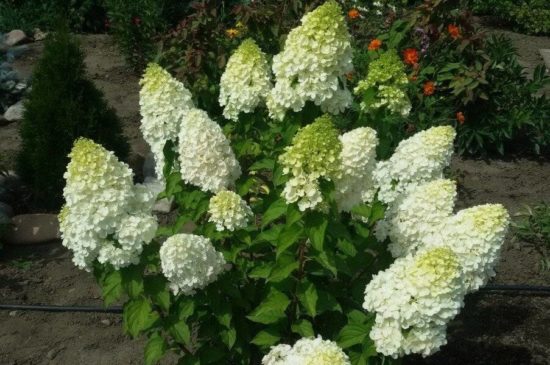
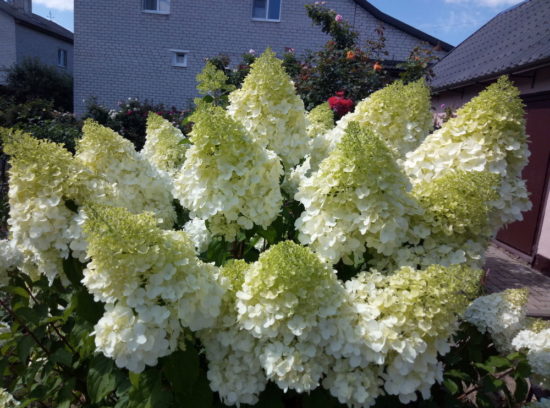
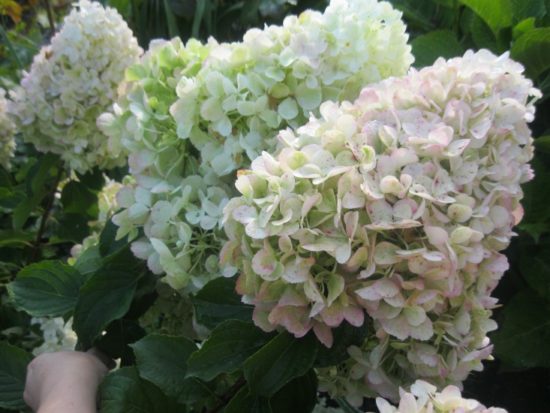
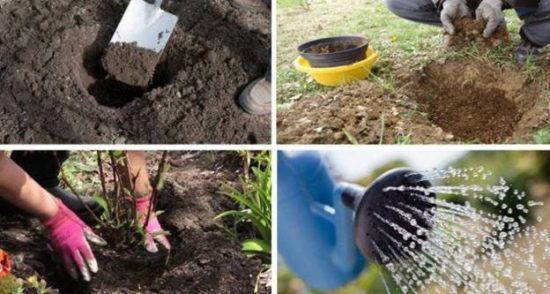
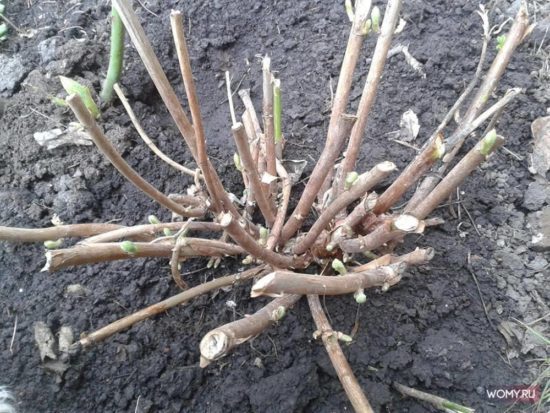
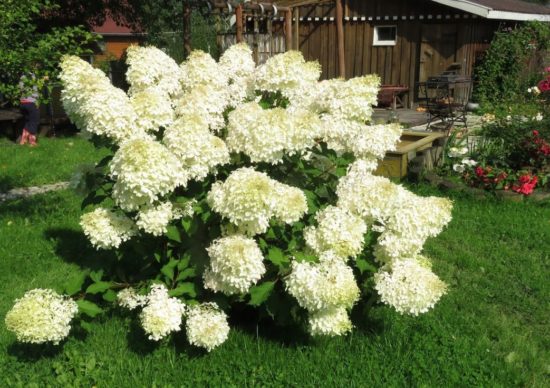
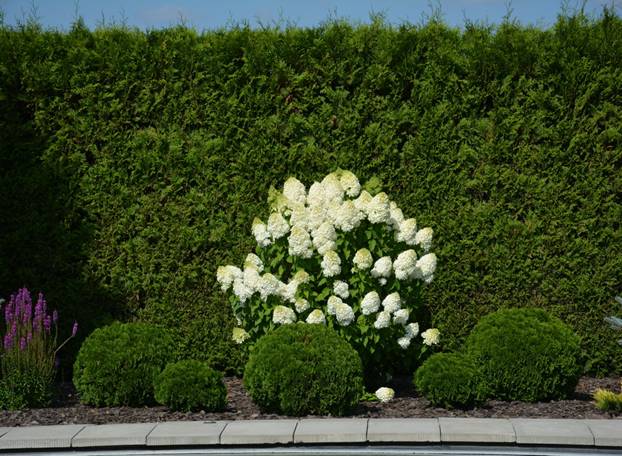
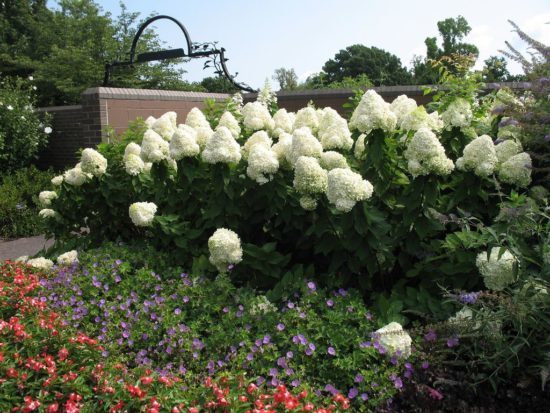
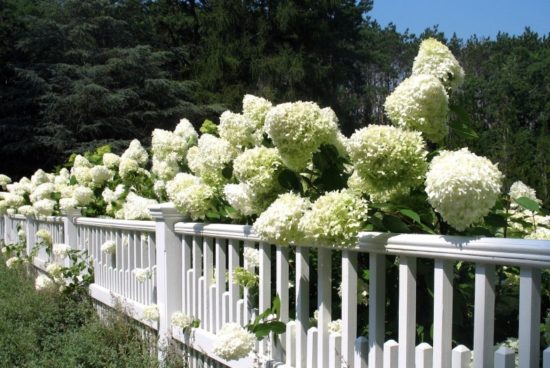

 CUCUMBERS NEVER GET SICK, I'VE BEEN USING ONLY THIS FOR 40 YEARS! I SHARE A SECRET WITH YOU, CUCUMBERS ARE LIKE THE PICTURE!
CUCUMBERS NEVER GET SICK, I'VE BEEN USING ONLY THIS FOR 40 YEARS! I SHARE A SECRET WITH YOU, CUCUMBERS ARE LIKE THE PICTURE! You can dig a bucket of potatoes from each bush. Do you think these are fairy tales? Watch the video
You can dig a bucket of potatoes from each bush. Do you think these are fairy tales? Watch the video
 How our fellow gardeners work in Korea. There is a lot to learn and just fun to watch.
How our fellow gardeners work in Korea. There is a lot to learn and just fun to watch. Eye trainer. The author claims that with daily viewing, vision is restored. They don't charge money for views.
Eye trainer. The author claims that with daily viewing, vision is restored. They don't charge money for views. A 3-ingredient cake recipe in 30 minutes is better than Napoleon. Simple and very tasty.
A 3-ingredient cake recipe in 30 minutes is better than Napoleon. Simple and very tasty. Therapeutic exercises for cervical osteochondrosis. A complete set of exercises.
Therapeutic exercises for cervical osteochondrosis. A complete set of exercises. Which indoor plants match your zodiac sign?
Which indoor plants match your zodiac sign? What about them? Excursion to German dachas.
What about them? Excursion to German dachas.